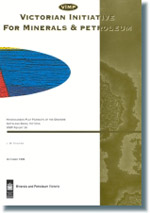VIMP Report 30 - Hydrocarbon play fairways of the onshore Gippsland Basin, Victoria
 |
| |||||
Product description:Download The downloadable version of this report is supplied in PDF format. Executive Summary Three hydrocarbon play fairways are interpreted across the onshore Gippsland Basin. Since these are relatively unexplored, a significant untested potential is considered to exist. The deepest and least explored play fairway is in the Early Neocomian at the base of the Strzelecki Group. In the prospective part of the onshore basin this objective is at a depth of 800 to 4000 m and has only been penetrated by four wells. These indicate a coarsening upwards clean sandstone overlain by a regional lacustrine mudstone. Oil shows have been encountered and maturation modelling indicates the interval to have entered the upper part of the oil window as early as 90 Ma in the Late Cretaceous. A substantial thickness of this source interval is interpreted towards the basin's depo-centre, in the offshore sector where numerous oil and gas fields have been discovered to date. Compressional features, fault truncations, and early forming stratigraphic traps are the expected plays in the Early Neocomian fairway. Since this unit directly overlies Palaeozoic granites and metamorphics, existing regional gravity data provides insights to numerous exploration leads. Some of these are significantly large. A second play fairway involving units of Late Cretaceous Golden Beach Formation exists across the central part of the basin, along the present shoreline. Based on borehole data, two sandstone intervals with good reservoir characteristics subcrop between thick seals of the upper Strzelecki and basal Latrobe Groups. This fairway has had a prevailing dip to offshore hydrocarbon kitchens. A third play fairway is supported by a regional correlation of 68 boreholes across the onshore basin. The resulting intra-Latrobe to base Latrobe isopach map provides insight to the pre-Latrobe Group palaeotopography. This work defines an intra-Latrobe play fairway with three prospective intervals. Since exploration to date has concentrated on top Latrobe features, these deeper units have received little or no attention. Borehole correlations indicate the top Latrobe erosional highs to be unrelated to the underlying intra-Latrobe units. Key aspects of the intra-Latrobe prospectivity are revealed by the correlation work. A sandstone which flowed 2044 BOPD at the Seahorse 1 well, 16 kms offshore, reaches a depositional limit against the pre-Latrobe palaeotopography in the northern part of the onshore basin. Regional sealing is by an overlying 50+ m unit which onlaps to a depositional limit against the palaeotopography. A similar relationship is evident for two deeper sandstones in broad palaeo-valleys mapped in the southern half of the onshore basin. These are sandwiched by regional seals and reach depositional limits against the pre-Latrobe palaeotopography. The prevailing regional dip to the basin's offshore depo-centre would ensure hydrocarbon migration into the intra-Latrobe fairway. Organic richness mapping and sequence stratigraphy in the offshore region indicate increased source potential for progressively younger Latrobe depositional systems, in the direction of the onshore basin. A previous study on the maturation of this source maps an oil mature region between the Barracouta Field and the present shoreline. Intra-Latrobe plays would include simple rollovers, such as at the Seahorse 1 discovery, and combined structural-stratigraphic traps at the reservoir's depositional limit against the pre-Latrobe palaeotopography. Traps of this type have been discovered in many basins. For the onshore Gippsland Basin there is little or no evidence of deliberate exploration for this play type to date. The past failure of plays based on top Latrobe Group structures may be due to flushing by meteoric water since the upper Latrobe units outcrop at the basin margin. In contrast, the underlying intra-Latrobe section terminates within the basin against the pre-Latrobe palaeotopography. Furthermore, the intra-Latrobe has a thick overlying seal interval which terminates and seals against the palaeotopography. Bibliographic reference Chiupka, J.W., 1996. Hydrocarbon play fairways of the onshore Gippsland Basin, Victoria. Victorian Initiative for Minerals and Petroleum Report 30. Department of Natural Resources and Environment. | ||||||

